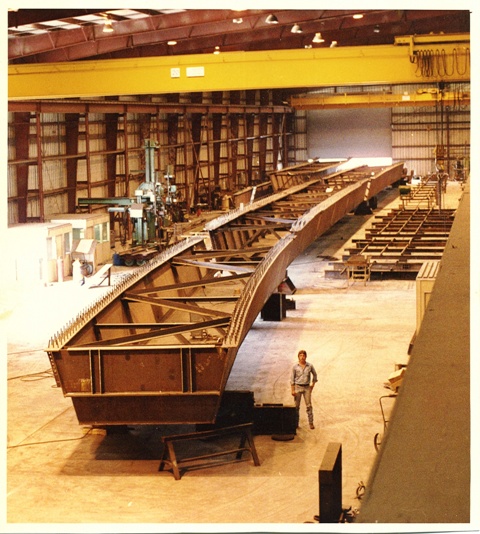

 By fabricator81
Date
By fabricator81
Date 01-30-2011 06:21
Edited 01-30-2011 20:25
Iron Head,
Yeah a little closer look at them makes you realize this wasn't a walk in the park.
The tubs were for an elevated wishbone ramp at a "park and ride" in Houston. There were five tubs in each string that started at the abutment and climbed to about 25'. The two strings of girders were one as built and the other opposite hand. This made the whole arrangement look like a giant wishbone with the ends going up and connecting to a cross over bridge. The tubs were all Fracture Critical and made with A588 weathering steel. The top and bottom flanges had the sweep cut into them [back then Texas would not allow heat curving on FCM flanges]. Obviously the bottom flange couldn't be heat curved anyways. The webs and top flanges were joined by SAW fillets to make a sub assembly. The bottom flange was set on that grid in the right side of the pic. The bottom flange had to be cradled and shimmed close to a level plane using modified shop camber dimensions. Then came the sub assemblies [TF and webs]. This was a true challenge since some of the girders were well over 100' with 3" of negative camber and several feet of sweep. As always, webs and flanges had to be completed to their finished length prior to the next assembly. So "No In Shop Field Splices" hah! hah!....Envision what the web camber looked like... Keep in mind that the webs are fit to opposite angles "and" on a radius in which the surface/bottom flange is not flat. On top of all this, there was a 1" to 3" twist built into each tub. IMO, the twists weren't really necessary but it sure made things pretty fancy from a design standpoint. The twist also made fit-up a living hell at times. And TxDot had every design engineer in the area dropping by throughout the project. I was just about to the point of telling them to start bringing their own transit and set it up themselves. We spent a lot of man hours catering to their verification wishes. Of course we were also covered up by the Texas Materials and Tests Technicians on a daily basis. Yeah, We were in the Lime Light for sure, but we did a quality job and they were pleased with our work. Camber and sweep were dimensioned at 10'-0 intervals and held to +/-1/4" in any 20'-0 segment plus the standard +/-1/8"x OAL/10-0' for the entire girder. I used a transit to verify both camber and sweep.On subs, we used string or the "hi-tech" mig wire on a winch.LOL! The 3rd tub in each string weighed right at 150k lbs. The lightest was 80k. I believe we had two 20 ton cranes in that bay. So once we assembled a tub, we had to use air tuggers, bolster carts, and a bunch of jacks to move it around in the shop. The tubs were moved off the grid and raised up to the final lay-down dimensions as you see them in the pic. Minmum of 3 girders during lay-down. All dimensions had to be verified again, ends final cut, match marked, and drilled for bolted splice plates.
Every once and awhile I have business on that side of Houston and drive under those tub girders. Out of all the bridge girders in Houston, those are still my favorite project.
BTW, funny now, but not then, the shop went belly up [no work] about a year after that project. No jobs in Houston, but Texas Materials and Tests offered me a spot. So I spent the next few years working on that side of the fence.
Im not working on the crane girder project but i see all the various processes
necessary to build these beasts lol. I can imagine how hard it would be to fit and weld
a radiused girder with neg camber. now these were some skilled craftsmen great explanation
Definitely a challenging task. All the SAW fillets were made with LT-7 tractors on fabricated track systems. Our normal work was providing jack-up rig TKY leg extensions, so I was fortunate to have some very skilled fitters on the crew. Miters, multiple angles, and "nothing is ever square" was normal for that shop. All in all we faired well and even the best learned/created some new tricks.
Tim I've never built anything like that before. Over the years I've been in shops to OK work to be done that they were building things of this nature. I only had to glance at your picture to visualize what it would take to built those tubs. Generally first thing I look at is how to do the layout, and how to control movement, and how to monitor movement. With those tubs my first thought was optics! Then weighted piano wire with batter boards.
Thanks for posting how you guys built those tubs!
I couldn't agree more with your approach "especially" the monitoring of movement. An optic system would have been great, but we were old school back then and made do with what we had.



